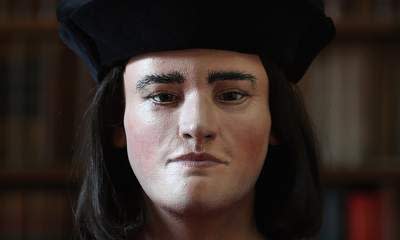Richard III: King's Face Is Revealed

The face of King Richard III has been unveiled to the world after a skeleton found under a council car park was confirmed as that of the 15th century king.
A facial reconstruction of the monarch has been released by the Richard III Society after it was confirmed that a skeleton unearthed in Leicester was that of the king who died in the Battle of Bosworth in 1485.
The image is based on a CT scan taken by experts at the University of Leicester, who discovered the king's skeleton during an archaeological dig last September with the help of the society.
King Richard III's skeleton was found in the remains of the choir of the Greyfriars church, which now lies under a social services car park in the city.
The facial reconstruction was unveiled at The Society of Antiquaries at Burlington House in Piccadilly, London.
Researchers said they had concluded "beyond reasonable doubt" that the skeleton, which showed evidence of an abnormal lateral curvature of the spine, was the monarch.
DNA samples from Michael Ibsen - a Canadian-born furniture maker who is a direct descendant of Richard's sister, Anne of York - provided further certainty.
The skeleton, with severe trauma to the skull, was unearthed on the first day of a three-week dig at the site of what is believed to have been the choir of Greyfriars Church.
Historical records show the long-lost church was the burial site of the monarch, following his brutal death at the battle of Bosworth Field in 1485.
The remains were found in good condition - with feet missing - at a depth of 68cm. The hand were crossed over the front of the pelvis and there was no evidence of a coffin or shroud found.
The king's remains will now be reinterred at Leicester Cathedral, the nearest consecrated ground, in keeping with archaeological practice.
But the discovery has sparked a row between Leicester and York, which claims King Richard III should be buried there according to his own wishes.
Kersten England, chief executive of City of York Council, said: "His self-identification with the north and York is reflected in his plans for a chantry of 100 priests in York Minster where he wished to be buried.
"That the burial site of this Yorkist king was determined by where he died from battle wounds makes the importance of adhering to his own wishes for his final resting place most important.
"City of York Council and all its political leaders are united in the belief that York is the most fitting burial place for Richard III, one of the city's most famous and cherished sons."
City of York Council will now write a letter to the Ministry of Justice stating its case.
Shakespeare portrayed Richard III as a hunchbacked tyrant but modern historians argue that the king was the victim of Tudor propaganda.
His brief reign from 1483 saw liberal reforms, including the introduction of the right to bail and the lifting of restrictions on books and printing presses.
Richard III was the last Plantagenet monarch, a Yorkist defeated by Henry Tudor, who became Henry VII.

 Yahoo News
Yahoo News 